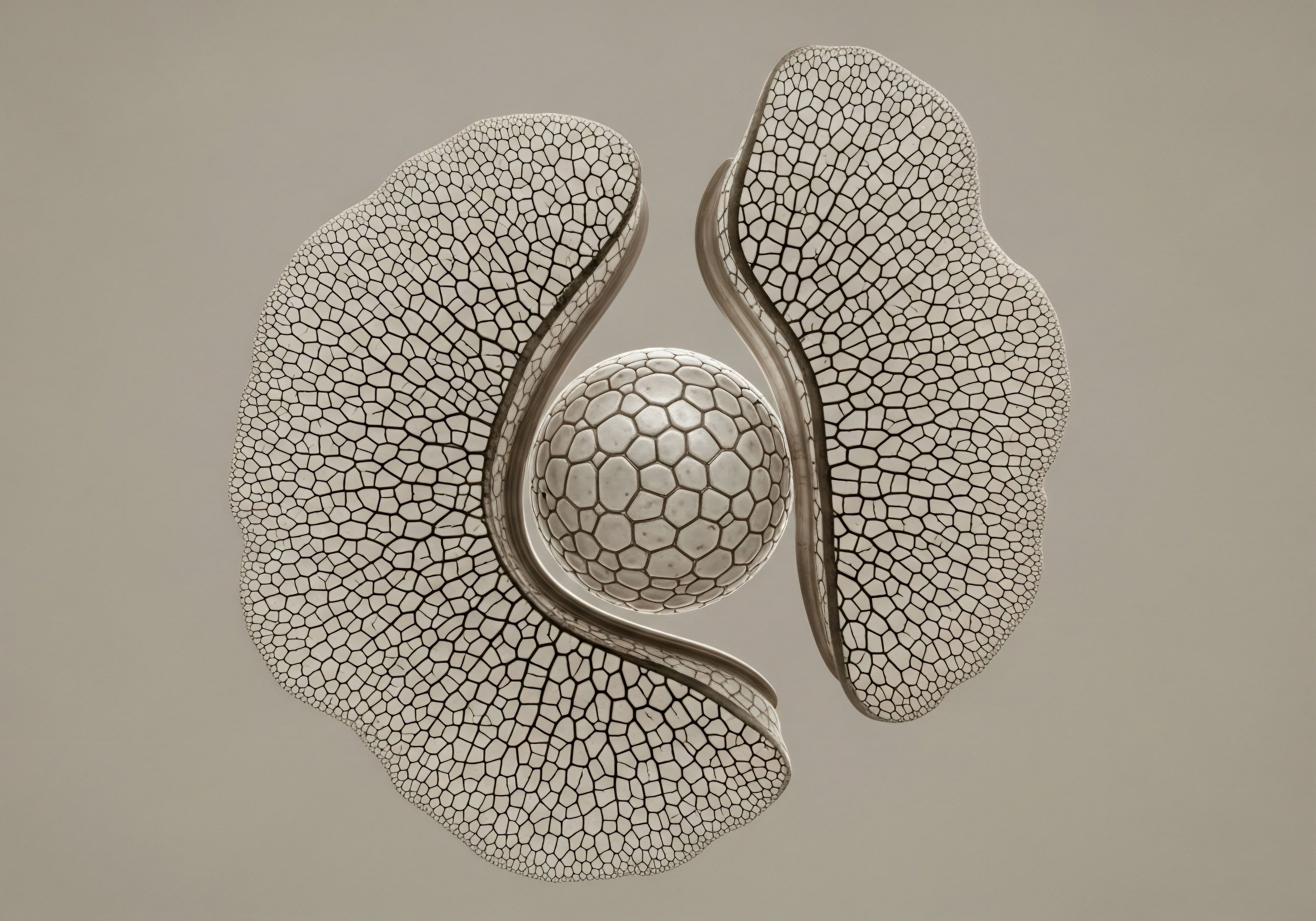

Fundamentals
The feeling of being out of sync with your own body is a deeply personal and often frustrating experience. You may notice persistent fatigue that sleep does not seem to resolve, shifts in your mood that feel disconnected from your daily life, or changes in your body composition that resist your best efforts.
These experiences are valid, and they are often the first signals of a deeper conversation happening within your biology. This conversation is moderated by your endocrine system, a complex network of glands that produce and release hormones. These chemical messengers are the architects of your vitality, governing everything from your energy levels and metabolic rate to your reproductive health and cognitive clarity.
Understanding that your daily choices are in a constant dialogue with this system is the first step toward reclaiming your biological autonomy.
The choices you make each day ∞ what you eat, how you move your body, the quality of your sleep, and the way you manage stress ∞ are not isolated events. Each one sends a specific set of instructions to your endocrine glands, influencing which hormones are released, in what amounts, and when.
A diet high in processed foods and refined sugars, for instance, can lead to chronically elevated insulin, a state that disrupts the delicate balance of other hormones, including testosterone and estrogen. Chronic stress elevates cortisol, which can suppress the production of sex hormones and thyroid hormones, impacting everything from libido to metabolism.
This is a system of profound interconnectedness. Your lifestyle choices are the inputs, and your hormonal state is the output. The long-term effects of these adjustments are cumulative, creating a biological legacy that can either enhance or diminish your health over time.
Consistent lifestyle inputs compound over time, shaping the foundational landscape of your hormonal environment and long-term health.

The Architecture of Hormonal Communication
To appreciate the long-term impact of lifestyle, it is helpful to visualize the body’s primary hormonal control center ∞ the Hypothalamic-Pituitary-Gonadal (HPG) axis. Think of the hypothalamus in your brain as the mission control, constantly monitoring your body’s internal and external environment.
It sends signals to the pituitary gland, the master gland, which in turn releases stimulating hormones that travel to the gonads (testes in men, ovaries in women). The gonads then produce the primary sex hormones, testosterone and estrogen. This entire system operates on a feedback loop.
When hormone levels are optimal, the gonads send a signal back to the hypothalamus and pituitary to slow down production. Lifestyle factors are powerful modulators of this axis. Chronic stress, poor nutrition, and lack of sleep can disrupt the signals from the hypothalamus, leading to a cascade of hormonal dysregulation that manifests as the symptoms you may be experiencing.
The body’s hormonal systems are designed for resilience, but they thrive on consistency. When you adopt lifestyle adjustments that support its natural rhythms, you are providing the raw materials for optimal function. A nutrient-dense diet provides the essential fatty acids, vitamins, and minerals that are the literal building blocks of hormones.
Regular physical activity enhances insulin sensitivity, improves the transport of hormones to their target cells, and helps regulate cortisol. Deep, restorative sleep is when the body conducts its most critical hormonal repairs and production, particularly of growth hormone. These are not temporary fixes. They are sustained practices that, over years and decades, create a state of hormonal equilibrium, protecting you from the chronic diseases associated with hormonal decline and promoting a longer, healthier life.


Intermediate
Understanding the foundational connection between lifestyle and hormones opens the door to a more granular, actionable approach. The long-term efficacy of these adjustments lies in their ability to modulate specific biological pathways. It is a process of recalibrating the body’s internal communication systems, moving from a state of chronic disruption to one of resilient equilibrium. This requires a deeper look at how specific lifestyle choices translate into precise biochemical signals that influence your endocrine health for years to come.
Consider the role of insulin, a hormone primarily known for its role in blood sugar regulation. Its influence extends far beyond glucose metabolism. Chronically elevated insulin levels, a condition known as hyperinsulinemia often driven by a diet high in refined carbohydrates and sugars, can have profound long-term consequences for your sex hormones.
In women, hyperinsulinemia can stimulate the ovaries to produce excess testosterone, a key factor in conditions like Polycystic Ovary Syndrome (PCOS). In men, it can increase the activity of an enzyme called aromatase, which converts testosterone into estrogen, potentially leading to an unfavorable hormonal ratio. A lifestyle adjustment focused on a whole-foods diet rich in fiber, lean protein, and healthy fats helps maintain insulin sensitivity, thereby supporting a more favorable long-term balance of sex hormones.

The Clinical Impact of Lifestyle Interventions
The table below outlines the direct, long-term effects of specific lifestyle adjustments on key hormonal systems. This is where the abstract concept of “healthy living” becomes a concrete strategy for endocrine optimization.
| Lifestyle Adjustment | Primary Hormonal Target | Long-Term Biological Effect | Associated Clinical Protocols |
|---|---|---|---|
| Resistance Training | Testosterone, Growth Hormone, Insulin | Increased muscle mass improves insulin sensitivity and provides a larger reservoir for glucose, reducing the likelihood of insulin resistance. It also stimulates the acute release of testosterone and growth hormone, supporting long-term lean body mass and metabolic rate. | TRT (Men and Women), Growth Hormone Peptide Therapy |
| Strategic Nutrition | Insulin, Leptin, Ghrelin, Estrogen | A diet low in processed foods and high in fiber and phytonutrients supports a healthy gut microbiome, which is crucial for estrogen metabolism. Maintaining stable blood sugar levels prevents the hormonal cascade associated with insulin resistance. | All hormonal optimization protocols |
| Sleep Hygiene | Cortisol, Growth Hormone, Melatonin | Consistent, high-quality sleep anchors the body’s circadian rhythm, leading to a healthy morning cortisol peak and a subsequent decline throughout the day. The majority of growth hormone is released during deep sleep, which is essential for cellular repair. | Growth Hormone Peptide Therapy, Adrenal Support Protocols |
| Stress Modulation | Cortisol, DHEA, Pregnenolone | Techniques like meditation and breathwork can lower chronic cortisol levels. This prevents a phenomenon known as “pregnenolone steal,” where the body diverts the precursor hormone pregnenolone away from producing sex hormones (like testosterone and estrogen) to produce more cortisol. | Adrenal Support Protocols, TRT (Men and Women) |

What Are the Long Term Consequences of Hormonal Imbalances?
The consequences of unaddressed hormonal imbalances extend far beyond the initial symptoms. Over time, these imbalances can contribute to the development of chronic diseases. For example, the estrogen decline seen in menopause is associated with an increased risk for osteoporosis and cardiovascular disease.
In men, low testosterone is linked to a higher incidence of metabolic syndrome, type 2 diabetes, and a decline in cognitive function. These are not inevitable outcomes of aging. They are the result of a prolonged period of hormonal dysregulation that can often be mitigated or prevented through sustained lifestyle interventions. The goal of these adjustments is to create a physiological environment that supports the body’s innate capacity for balance, thereby reducing the long-term disease risk.
Strategic lifestyle interventions function as long-term biological investments, directly influencing specific hormonal pathways to mitigate chronic disease risk.
The application of these principles can be seen in clinical practice. For a man undergoing Testosterone Replacement Therapy (TRT), lifestyle adjustments are not merely complementary; they are synergistic. A diet that supports insulin sensitivity can enhance the body’s response to testosterone. Regular exercise helps manage aromatization, reducing the need for ancillary medications like Anastrozole.
For a woman in perimenopause, a lifestyle that prioritizes stress management and sleep can help stabilize cortisol levels, potentially lessening the severity of symptoms like hot flashes and mood swings. These are powerful examples of how you can actively participate in your own hormonal health, creating a foundation that enhances the efficacy of any clinical protocol you may undertake.
- Dietary Composition ∞ The ratio of macronutrients ∞ protein, fats, and carbohydrates ∞ can significantly influence hormonal signaling. A diet with adequate protein supports satiety and muscle maintenance, while healthy fats are essential for the production of steroid hormones like testosterone and estrogen.
- Exercise Modality ∞ Different forms of exercise elicit different hormonal responses. While resistance training is a potent stimulator of anabolic hormones, endurance exercise can improve insulin sensitivity, and practices like yoga can help lower cortisol. A combination is often most effective.
- Circadian Alignment ∞ Aligning your sleep-wake cycle with the natural light-dark cycle is a powerful tool for hormonal regulation. This means aiming for consistent bedtimes and wake times, and getting exposure to natural light in the morning.


Academic
From a systems-biology perspective, the long-term influence of lifestyle on hormonal health is a function of its ability to modulate the intricate feedback loops that govern endocrine function. The Hypothalamic-Pituitary-Gonadal (HPG) axis, the Hypothalamic-Pituitary-Adrenal (HPA) axis, and the Hypothalamic-Pituitary-Thyroid (HPT) axis do not operate in isolation.
They are deeply interconnected, and a perturbation in one can have cascading effects on the others. Lifestyle adjustments represent a form of chronic, low-dose signaling that can, over time, recalibrate the setpoints of these axes, leading to a more resilient and adaptive endocrine system.
One of the most compelling areas of research in this field is the interplay between metabolic health, inflammation, and hormonal function. Chronic low-grade inflammation, often driven by a sedentary lifestyle and a diet high in processed foods, can induce a state of “hormone resistance.” In this state, the cellular receptors for hormones like insulin, thyroid hormone, and even testosterone become less sensitive.
This means that even if the body is producing adequate amounts of a hormone, it cannot exert its effects efficiently at the target tissues. A lifestyle rich in anti-inflammatory foods (such as those containing omega-3 fatty acids) and regular physical activity can, over the long term, reduce systemic inflammation, thereby improving hormonal sensitivity and overall endocrine function.

How Does Gut Health Affect Hormonal Regulation?
The gut microbiome has emerged as a critical regulator of systemic hormonal balance, particularly in the context of estrogen metabolism. The collection of bacteria in the gut, known as the estrobolome, produces an enzyme called beta-glucuronidase. This enzyme deconjugates estrogens that have been processed by the liver and excreted into the gut, allowing them to be reabsorbed into circulation.
A healthy, diverse microbiome maintains a balanced level of beta-glucuronidase activity, contributing to stable estrogen levels. Lifestyle factors, particularly diet, are the primary determinants of microbiome composition. A diet high in fiber and diverse plant foods supports a healthy estrobolome, while a diet low in fiber and high in processed foods can disrupt it, leading to either an excess or a deficiency of circulating estrogen.
This has profound long-term implications for conditions such as endometriosis, PCOS, and even the risk of hormone-sensitive cancers.
| Lifestyle Factor | Microbiome-Mediated Mechanism | Long-Term Hormonal Consequence |
|---|---|---|
| High-Fiber Diet | Provides substrate for beneficial bacteria, promoting diversity and the production of short-chain fatty acids (SCFAs) like butyrate. | Butyrate helps maintain gut barrier integrity, reducing systemic inflammation. A balanced microbiome supports optimal estrobolome function, leading to stable estrogen levels. |
| Probiotic and Fermented Foods | Introduce beneficial bacterial strains that can help modulate the immune system and compete with pathogenic bacteria. | Improved gut health can lead to better regulation of cortisol via the gut-brain axis, and more efficient metabolism of hormones. |
| Chronic Stress | Can alter gut motility, increase intestinal permeability (“leaky gut”), and shift the composition of the microbiome toward less favorable species. | Disruption of the gut-brain axis can lead to dysregulated cortisol output. Increased intestinal permeability allows inflammatory molecules to enter circulation, contributing to systemic inflammation and hormone resistance. |
| Sedentary Behavior | Associated with lower microbial diversity and a less favorable gut environment. | Contributes to the low-grade inflammatory state that can impair hormonal signaling and receptor sensitivity throughout the body. |

The Epigenetic Impact of Lifestyle
Beyond the direct biochemical effects, lifestyle adjustments can have long-term consequences through epigenetic modifications. Epigenetics refers to changes that alter gene expression without changing the underlying DNA sequence. Lifestyle factors like diet, exercise, and stress can cause methylation or acetylation of genes involved in hormone production and receptor function.
For example, certain dietary compounds can influence the expression of genes that code for aromatase, the enzyme that converts testosterone to estrogen. Chronic stress can lead to epigenetic changes that increase the expression of genes involved in the inflammatory response. These changes can be long-lasting and, in some cases, even heritable. This means that the lifestyle choices you make today are, in a very real sense, programming your hormonal future at a genetic level.
Sustained lifestyle choices can induce long-lasting epigenetic modifications, altering the expression of genes that govern hormonal production and sensitivity.
This understanding elevates the importance of lifestyle interventions in clinical protocols like TRT or peptide therapy. A patient’s lifestyle choices can directly influence their epigenetic landscape, potentially enhancing or diminishing their response to treatment.
For example, a lifestyle that promotes a healthy inflammatory response can create an epigenetic environment that is more receptive to the anabolic signals of testosterone or the restorative effects of growth hormone peptides like Sermorelin or Ipamorelin. This systems-level view, which integrates metabolic health, the microbiome, and epigenetics, provides a more complete picture of the profound and enduring impact of lifestyle on hormonal health.
- Metabolic Endocrinology ∞ The study of how diet and metabolism influence hormonal systems. The long-term consumption of a ketogenic diet, for example, has been shown to have significant effects on insulin, glucagon, and sex hormone-binding globulin (SHBG).
- Immunoendocrinology ∞ This field explores the bidirectional communication between the immune system and the endocrine system. Chronic inflammation, as a function of lifestyle, is a key modulator of this interaction.
- Chronobiology ∞ The study of the body’s internal clocks. Aligning lifestyle behaviors, particularly sleep and meal timing, with the body’s natural circadian rhythms is a powerful intervention for optimizing the release of hormones like cortisol, growth hormone, and melatonin.

References
- Baksu, Basak. “Long-Term Effects of Hormonal Problems on Women’s Health.” 2025.
- Endocrine Associates of West Village. “How Lifestyle Changes Can Help Restore Your Hormonal Health.” N.d.
- Velloso, C. P. “Hormonal and Metabolic Changes of Aging and the Influence of Lifestyle Modifications.” Aging and Disease, vol. 9, no. 1, 2018, pp. 1-2.
- Natural Endocrinology Specialists. “Lifestyle Habits That Can Affect Your Hormones.” 2023.
- Nelson Hospital. “How Lifestyle Choices Affect Hormonal Imbalance in Women in 2024?” 2024.

Reflection
The information presented here provides a map of the biological terrain, illustrating the profound and lasting connections between your daily actions and your internal hormonal state. This knowledge is a tool, and its true power lies in its application. Your body is a unique and dynamic system, and the journey to optimal hormonal health is a personal one.
The sensations you feel, the changes you observe, and the goals you hold are the starting points for this journey. Consider where you are now, not with judgment, but with curiosity. What is one small, sustainable adjustment you could make today that would send a positive signal to your endocrine system?
The path to long-term vitality is paved with these consistent, intentional choices. It is a process of becoming an active collaborator in your own well-being, using this understanding as a compass to guide you toward a future of greater health and function.



